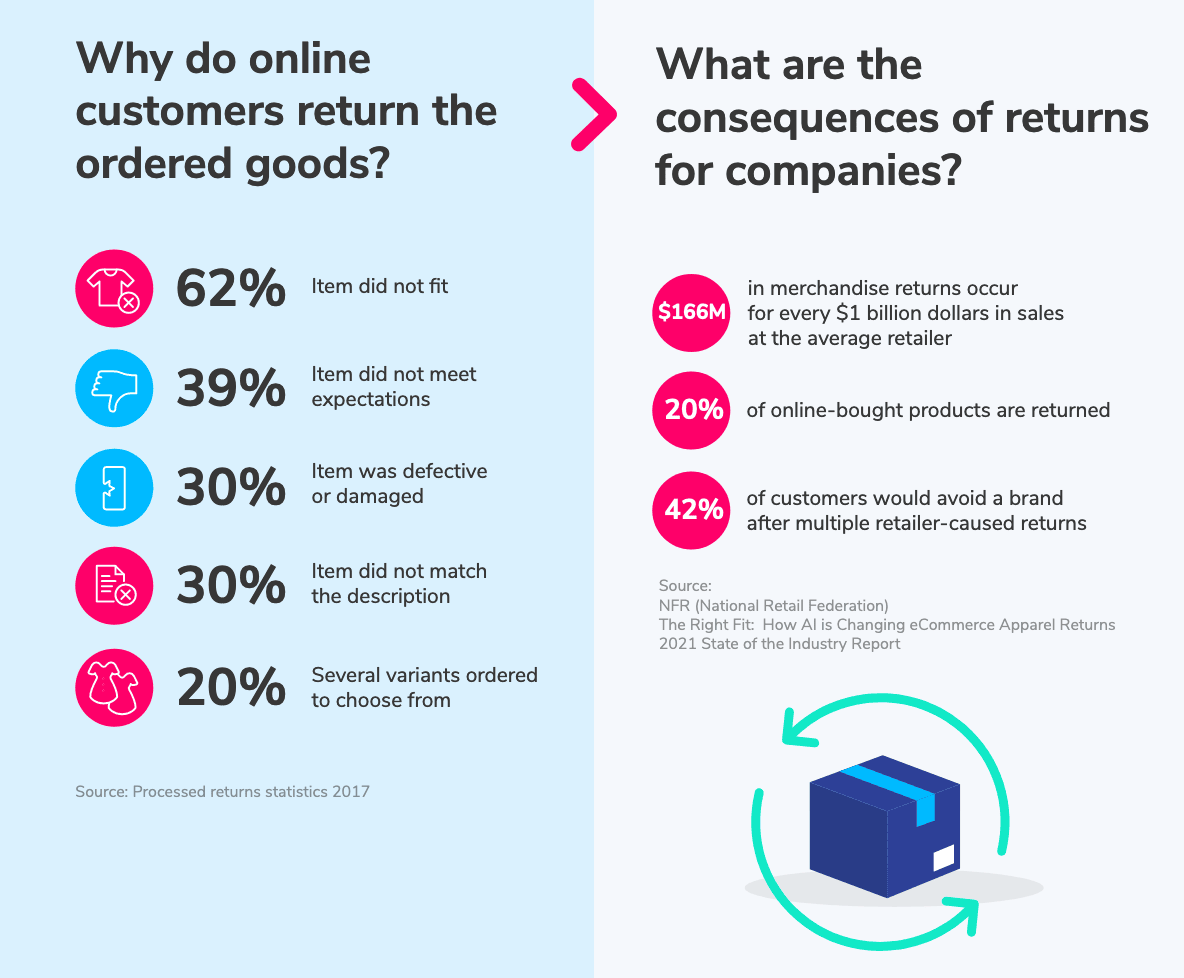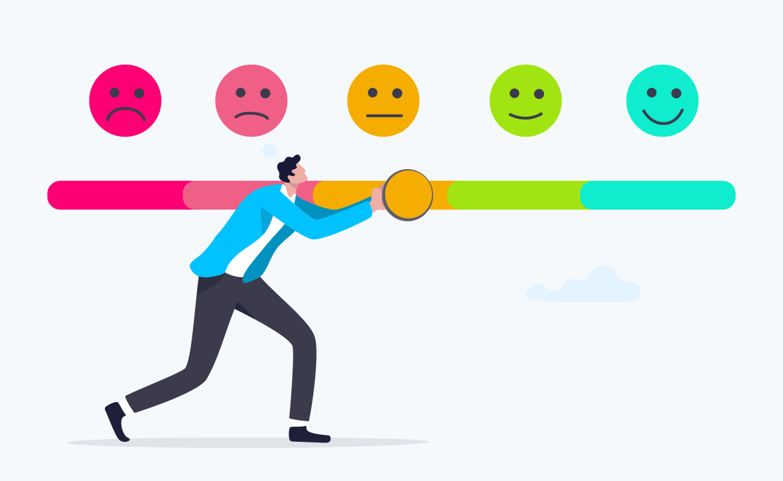Mastering customer experience
But before you delve into ROX, you must first target your customers. To encourage positive customer experiences, you must understand what your customers expect, and what bothers and excites them.
For example, approximately 26% of online shoppers find account creation frustrating when placing an order, and 45% abandon their purchase if product information is incomplete or unclear.
Such factors lead to one-fifth of customers buying less, never buying from a company again, or even abandoning a purchase process in the middle.
Understanding your customers is the key to anticipating their needs and exceeding their expectations.
What bothers customers when shopping online?
- 32% mandatory customer account
- 30% inconvenient return
- 28% inaccurate delivery time
- 25% non-transparent shipping costs
- 22% incomplete-non-transparent product information
Understanding your target customers' needs
Achieving strong ROX requires the right balance of service, engagement, and measurement.
- Service: Excellent customer support, quick responses, and easy feedback forms improve customer satisfaction and loyalty.
- Marketing: Personalized, data-driven campaigns enhance engagement and increase click-through rates.
- Measures: Tracking key metrics like conversion rates and cost of investment helps businesses refine strategies and stay ahead.

Source: PWC, Global Consumer Insights Survey 2019
How positive customer experiences work
Satisfied customers who’ll stick with you over the long term. That’s the dream for any business, right? But to turn it into reality, companies need to close the gap between customer expectations and the actual customer experience.
Customers expect their buying journey to be seamless from purchase to delivery and they want easy access to product information.
Positive digital experiences lead to:
- 4x more willingness to buy
- 4x higher repurchase rate
- 7x more cross-selling turnover
- 6x higher motivation to recommend
For example, if someone orders a cross-trainer, they will want to know about the device’s features, how it is packaged and shipped, and how long it will take to arrive.
If these expectations are met, the customer is more likely to buy other sports equipment from the same retailer or manufacturer.
How to calculate Return on Experience (ROX)
To calculate ROX, you’ll need to consider the profit generated divided by the capital employed to create a particular customer experience.
Here’s the Return on Experience formula:
Profit is calculated based on sales minus the cost of CX efforts to increase customer satisfaction.
ROX = revenue (net) - cost of CX efforts/cost of CX efforts
If, for example, the delivery time of a cross-trainer (see example above) is a criterion for a positive customer experience, the ROX is calculated based on the revenue and the cost of delivery on the desired date.
ROX = Revenue from the cross trainer (net) – cost of delivery on the desired date/cost of delivery on the desired date
ROX should ideally be higher than 0 so that CX efforts — in this case, the preferred delivery date — can pay off. However, an ROX of 0 would indicate that CX efforts improved customer satisfaction but did not bring any immediate revenue to the company.
At this point, you can compare sales before and after enabling the user to pick the delivery date.
To simplify your ROX calculations, consider using a Return on Experience template to structure your data, track performance metrics, and optimize customer experience investments.
Maximize your ROX initiative
To maximize Return on Experience (ROX), businesses should implement a multifaceted approach that combines personalization, data-driven insights, seamless system integration, and omnichannel experience management.

Here are key strategies to consider:
Tailored customer experiences
Tailor your products, services, and communications to match individual customer preferences. By leveraging customer data, you can create personalized experiences that resonate with each customer, fostering loyalty and increasing repeat purchases. Use personalized product recommendations and targeted marketing messages to improve the customer journey.
Smart data for smarter business decisions
Use data analytics to gain actionable insights into your customers’ behaviors, preferences, and pain points. By analyzing this data, you can make informed decisions that enhance their experience. Implementing advanced analytics tools will help track key performance indicators (KPIs) related to customer interactions, allowing for continuous improvement.
Connected business ecosystem
Seamlessly integrate your customer experience initiatives with other business systems, such as Customer Relationship Management (CRM), Enterprise Resource Planning (ERP), and product data-based systems like Product Information Management (PIM). This ensures a unified approach to managing customer interactions, facilitates real-time data sharing, and provides a holistic view of the customer journey.
Seamless omnichannel journey
Ensure that your customers receive a consistent and seamless experience across all touchpoints — whether in-store, online, or on mobile applications. An omnichannel strategy guarantees that every interaction feels connected and personalized, which boosts customer trust, satisfaction, and loyalty.
What role does product information play in ROX (Return on Experience)?
CX initiatives often involve handling technical data and content, particularly in eCommerce. Unlike a traditional retail store, where customers can try and test the product in person, eCommerce doesn't have that option.
Therefore, the product information you provide can significantly impact the customer experience and your ROX. This is where a Product Information Management (PIM) system comes to the rescue.
A PIM system helps you increase ROX because...
- ... better product data creates more transparency for customers, reduces the rate of returns, and saves costs.
- ... better product data ensures that fewer shopping carts are abandoned. As a result, companies not only secure the sales they would otherwise lose but also boost their business.
- ... providing complete, accurate, and personalized product information positively influences the customer experience and ensures more sales.
- ... it stores, organizes, and manages information that helps nudge a customer towards a buying decision, including product specifications, retailer and manufacturer information, product availability, warranty, shipping, and customer reviews.
- ... it can store, organize, and manage product reviews, which enhance the customer experience and facilitate faster purchase decisions.
The Return on Experience – the impact of product information
Product returns entail additional costs for companies; items must be collected, organized, and repackaged or put away.
These processes involve costs that could be avoided if customers were provided with accurate and complete product information about the purchased item.
The example below illustrates the role that product information plays in achieving an excellent ROX.

Conclusion: Become a ROXstar!
Whether you’re targeting B2B or B2C clients, delivering superior digital customer experiences is the key to customer success, retention, and business growth.
ROX may seem an insufficient metric to quantify business success. But if you consider the advantages of investing in customer satisfaction, you can quickly conclude the following: CX and retention go together.
After all, happy customers stick around, and positive interactions develop loyalty — and loyalty can hardly be quantified in monetary terms!








